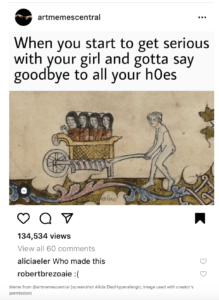What Makes Medieval Art So Meme-able?
Medieval imagery wasn’t meant to be funny when it was made hundreds of years ago, but all over Instagram it has been remixed, captioned, and somehow reads as peak hilarious — depending on your sense of humor.
One evening while wasting time on the addictive social media platform, I came across a meme of a medieval battle scene; on the right, a horse was giving the sword-wielding dude some serious side-eye. The caption read: “When you acting hard in front of the squad but your horse knows you a bitch.”
I laid in bed staring at the tiny screen in my hands, laughing maniacally, posting it to my Instagram story and sending it to all my close friends. How could this seemingly arcane medieval imagery, previously confined to an art museum or, perhaps, a European crypt, feel so meme-able? Was it the meme’s imagery or the caption above it? I had to find out.

“It’s funny for the same reason that Black American Vernacular English is so sticky — because it references a level of servitude that we don’t want to admit,” said artist Kenya (Robinson), whose work often explores privilege, consumerism, and perceptions of gender, race, and ability. She noted that the text is written in Black American Vernacular English, also known as the language of social media. “The meme is showcasing the fact that we are all peasants,” she added.
That’s the text. But what about the image and the side-eye horse? It actually portrays the “Captivity of Jeholachin King of Israel,” which isn’t particularly funny. Babylonians destroy the Temple of Jerusalem, then lead the Jews into captivity. (As a Jewish person, this makes the meme feel very unfunny, and more like a story my grandma, or bubbe as we say, might have told over a holiday dinner.) The title refers to the defeated king of Jerusalem. The image, in fact, is not even an original — it’s a 19th-century reproduction.
But the fact that the image suddenly appears hilarious in this remixed context struck me. I tried to think back to my medieval art history class in college, but then remembered that I had dropped it shortly after I signed up.
Read the full story here:



